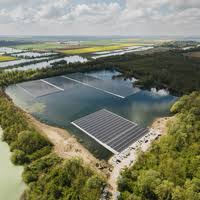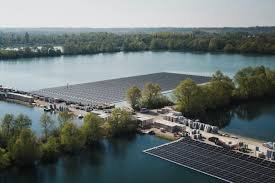Europe moves a notch higher in its search for renewable energy sources as it prepares to host the Europe’s largest solar plant: Les Îlots Blandin in Haute-Marne. this is the first such venture, which will take up 127 hectares of land that were used for gravel extraction thus changing what was once an industrial land into a powerhouse of renewable energy.
Project overview
Q ENERGY has a planned refining capacity of 74. 3 MW Les Îlots Blandin was ready to become one of the leaders in the European renewable energy market. It is planned that the installation will comprise 134,649 solar panels which will be placed in the optimal arrangement for power accumulation. The “Îlots Blandin,” plant can potentially generate double the current total energy capacity than the largest floating solar park in Europe. “For instance, we are in the process of carrying out big floating parks around the world like a 296 MW solar park in Taiwan,” pointed out Vincent Grumetz, Director of Ciel & Terre EMEA, while referring to Les Îlots Blandin as a significant break through for floating solar energy in Europe.

The project itself is massive and is indicative of an emerging focus on harnessing square footage that has not heretofore been used to harvest solar power in the form of water. In addition, floating solar power plants require only a small area of land; thus, it keeps environmentally sensitive land intact. Also, Floating solar panels yield more output due to the effect of water they work under cooler environment and no water evaporation especially in areas of high intensity in solar radiation.
Scope
Les Îlots Blandin will generate power for approximately 240 households per year which translates to 37,000 individuals. Also, this considerable output points out the benefit of floating solar technology in generating energy for national and regional power systems. In addition, the plant will help to address issues of climate change since it will cut an estimated 18,000 tone CO2 emission per year.
Issues in the engineering area, such as the use of the system of anchors to maintain the panels and make them fully floating and withstand different types of weather conditions. However, they also carry certain benefits that include ease access for service and least roof shadowing by vegetation. Hence, the application of the new technology in the context of the Haute-Marne project will be a good case to learn how to overcome these challenges and how to get the best out of the new technology. In an economic viewpoint the project is social capital intensive and will provide employment during construction stage and maintenance employees once operational. The extensive development of renewable energy projects also calls for the development of more projects that can fuel sustainable development.
The construction of Les Îlots Blandin complies with France’s general objective to increase reliance on renewable sources of power and to decrease use of fossil fuels. And since no one wants to be eliminated in such a business, it creates a benchmark for other similar projects across Europe and hence proving the efficiency of floating solar power technology.
Completion date
Once the plant is fully online by early 2025, it will be providing clean energy the industry needs but equally as important, information on the potential and real-life experience from the large-scale floating solar farms. It will also be useful in applying such projects on a large scale in other parts of the globe. Les Îlots Blandin is therefore, a remarkable step forward when it comes to building infrastructure for renewable energy.
Floating solar power in France is a perfect example of how a country is using technology and practical solutions to address the issue of climate change and consequently capture the future by tapping into renewable energy sources. This project is one of the way that demonstrate how the world needs to come up with new ways in providing energy for the world so as to fight against the challenges of climate change.
Read also Ellinikon: Europe’s Largest Smart City Project Underway in Athens
Read also Construction Commences on the $8B World’s Longest Underwater Rail and Road Tunnel in Europe
